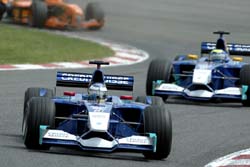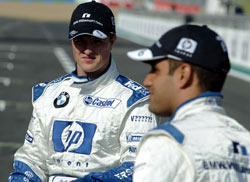
Eddie Irvine believes his approach to driving style is similar to that of ex-Ferrari team mate Michael Schumacher's - and radically different to current colleague Pedro de la Rosa's technique. And that, he believes, is part of the reason for the difficulties in sorting out the Jaguar R3's problems.
"I carry a lot more speed into the corner than Pedro and drive a lot more like Michael," he says. "We both barrel into the corner and then sort it out mid-corner. This car (the Jaguar), when you get it there, you can't sort it out. I'm getting murdered on the exit. Pedro has always been marginally better on the exits but overall I'd be quicker. In this car, he's just killing me on the way out of the corner."
Is that because de la Rosa is more adaptable perhaps? "He really concentrates on exits and I don't," explains Irvine. "I focus on getting car to apex as quick as I can. He really focuses on the exit just like Rubens (Barrichello)."
"All year he's been quicker in the R3 than me. I think my style's better in a car that works. I don't think the way to do it is change style but to change the car. I've driven with Michael, that's the way he does it. He's the best driver. When I went there I always believed the best way to drive is the way I drive and when I went to Ferrari I even took it further down that road because I saw what Michael was doing."
Interestingly the gap in qualifying performance between the five time champion and his Ferrari team mate has dropped off markedly this season. And there is a reason for that. At Benetton in the mid 1990s Schumacher's race machine was on a knife-edge. It was fast and competitive but had tricky oversteer. It was only Schumacher's talents that kept it in line - and he actually won two world championships with it.
When he left in 1996 Gerhard Berger stepped into the breech, confident he could do everything the young German could. It didn't take long for his illusions to be shattered. "On the first day I comfortably got close to Michael's time and then thought 'Tomorrow, I'll just do those few extra tenths'. But when I tried it I crashed three or four times and that made me think 'wow Michael'. The car was nervous but he managed to hold it there not just for one lap right on the edge, but for 50, 60 or 70 laps."
It was that precision that earned Schumacher victories his team mates could only dream of - and championships at the expense of Irvine and Barrichello. But this season the gap has closed markedly. Technical director Ross Brawn and his design team have to take the credit for that - or blame. Schumacher's phenomenal control was what made the difference with a bad car. But with a good one the gap closed.
"Michael doesn't like an oversteering car, but he can cope with it more than other drivers," says Brawn. "Rubens doesn't like a car that is in any way nervous. He can drive it but it is not what he prefers. Michael just copes with it. That is one of the things about this year's car. In the past there has been more of a gap between our drivers but this year's car is a bit more stable and that is why the gap has narrowed. Michael doesn't want an oversteering car, he can just deal with it better than Rubens."
The Ferrari has generally been better on the tracks with faster corners and
suffered on the slower ones like Monaco, hence (partly) Schumacher's defeat
there at Coulthard's hands. Michelin made a special effort for Monaco, got the
front row and the Scot started lighter and faster than Juan Pablo Montoya, got the jump at the start and
the game was up. Of course Ferrari and Bridgestone worked on that and the result
was that nearly three months later they walked it at Hungary, which is a fairly
similar track.

The FW24 Williams has become famous for eating its rear tyres - and while the McLaren is nimbler on its Michelins, Montoya and Ralf Schumacher are often left with a massive struggle against oversteer late in each stint. Montoya's slide with Coulthard at the European Grand Prix, which ended both their races, was one of the results. He braked late defending his line and with shot tyres, the back end hit the McLaren. Montoya apologised but Coulthard was less than impressed. He believed it was a triumph of brawn over brains because the behaviour of the Michelins on the Williams is well known.
But Murphy's Law applies in motor racing too. At Imola Montoya went to the grid with understeer, figuring the oversteer would increase as the race went on and hence the car's performance increase as the balance improved. For some reason at this one track the oversteer never made an appearance and Montoya never figured in the hunt for victory.
Like Schumacher, Montoya likes a car which is pointier that Ralf Schumacher's. "Our set ups are quite close," says the Colombian. "He doesn't mind the understeer as much as I do. You get to a point where you go around the corner [crossed hands] and the thing still goes straight on. It's really bad. I like a good front end so when you want to go there the car does it."
"When you've got that it's very easy to go quick and you can position the car wherever you want. When you have got understeer you turn in and don't know if you are going to go where you want or be one or two metres wide. As soon as you've got that you lift off the throttle and then you are losing time."
Jacques Villeneuve likes to throw a car around as much as Montoya and the Canadian has a very short and sensitive pedal travel compared to Olivier Panis, who has long travel in the other BAR. So how is Montoya's throttle set up? "Sod knows," he says, shrugging his shoulders. "That's too technical a question for me."
Which all goes to show, sometimes even the greatest drivers are simply doing what comes naturally. As the old maxim goes: you can learn to be a good driver, but you are born a champion.